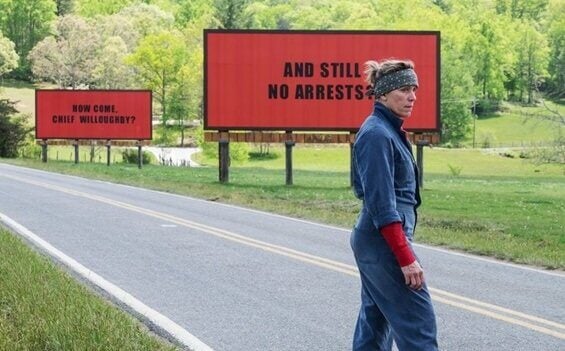Three Ads for a Crime brings a shocking cinematic reflection on the anger and despair contained in pain. It is the pain of a mother, Mildred Hayes, who creates three posters in her city denouncing the passivity of the police after the rape and murder of her. Daughter. However, these messages, far from being answered with empathy by the neighbors, are greeted with great discomfort.
Earlier this year, the Hollywood Academy of Motion Picture Arts and Sciences held its gala, the Oscar, and many were convinced that, despite all the bets and thanks received above, Three Ads for a Crime would not win the best prize. Film.
- “For love comes calm.
- And for calm comes thought.
- And sometimes you need to know.
- Jason.
- Ni you even need a gun.
- And you certainly don’t need hate.
- Because hate never solves anything.
- But calm does.
- Try it for a change.
- Willoughby.
- “Three ads for a crime?”.
If these three red posters placed in a city by a desperate mother have disturbed the community, the film has been greeted with the same discomfort by many American areas. History, for one thing, takes place in a Missouri town in the heart of America. States, which evokes a subtle, non-casual metaphor.
There, in this ambiguous landscape, we find ourselves in a seemingly normal territory, where we gradually discover how justice is circumvented and how violence is a language capable of articulating almost all space, we see it in the police, which does not hesitate to resort to torture. , we see it in the gender codes, in the passivity of the neighbors who choose to look away, and even in the black humor, where all the characters drag wounds, traumas before which anger is the only channel that they have left.
Three commercials of a crime is not a comfortable film, it is an angry and indignant portrait of a woman seeking justice, but it is also much more, because like all fable (albeit acidic and with bitter traces), there is a final transformation, because hope is that brushstroke that must always survive, even in the most unfavourable and desperate situation.
Few things can be more devastating than losing a son, but the suffering is even greater if this loss is the result of a violent death, a murder, a rape, we all know a case, and perhaps that is why it is not difficult to assume the role of Midred Hayes, this woman of suspicious expression and attracted by anger, who is still waiting for answers seven months after the tragic loss of her teenage daughter.
Most impressive of all, this character should initially cause us some discomfort because of his behavior: it is unpredictable, his dialogues are full of disgust and contempt, and in fact, he does not hesitate to use violence in more ways than one. a chance. However, Mildred Hayes is the emotional engine of the film and it is impossible not to show empathy with it, it is inevitable to understand every gesture, every movement, every action undertaken, sometimes with extreme violence.
We are faced with a character beautifully played by Frances McDormand, who uses anger in response to helplessness and vulnerability, is in a way the embodiment of that anger born of love and can only scream, which externalizes his despair through three posters. waiting for results.
Three Ads for a Crime director Martin McDonagh was criticized at the time for being an Anglo-Irish playwright who wanted to show a portrait of central America led by simple cliché: racism, homophobia, ignorance, dysfunctional families, violent police, lifeless population, sexual violence, machismo?
To keep the superficial, to keep the simple critical crust that uncomfortable in many parts of America would be to lose the true greatness that this film encloses, each character shows equally the same capacity for violence and the most indescribable goodness. The people we were willing to hate at the beginning of the film fled our certainty to confuse us and then become something new and hopeful.
The psychological virtuosity of the film is immense, because despite the rawness of the central plot with a mother denouncing the police’s inaction in the case of her daughter, there is room for comedy, for friendship, and above all for a letter full of hope. who talks about love and changes everything.
There is a mixture between the absurd and the transcendental that composes a work where emotions are always the real protagonists, those that give real meaning to a strange scenario where their characters, although still on fire, love them.
In conclusion, although Three Ads for a Crime is not based on a real story, unfortunately its argument is familiar, it is the symbolism and catharsis of all those who have lost their children and who still do not have answers, living among lagoons. and in the silence of a society that has already left them behind. These posters are our conscience, uncomfortable for many, and the only resource for others.

